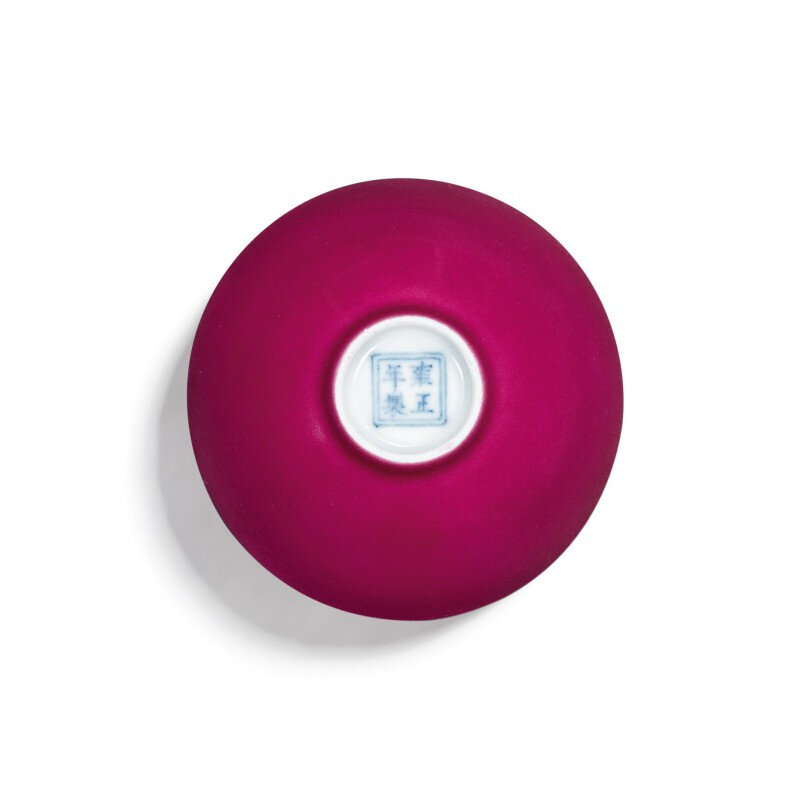A fine and extremely rare ruby-red cup, Mark and period of Yongzheng
Lot 13. A fine and extremely rare ruby-red cup, Mark and period of Yongzheng (1723-1735); 6.5 cm. Estimate: 4,000,000- 6,000,000 HKD. Lot sold: 6,225,000 HKD. Courtesy Sotheby's.
finely potted with rounded thin sides springing from a short slightly tapered foot, the exterior evenly covered with a rich, ruby-coloured enamel, the base inscribed in underglaze blue with a four-character reign mark within a double square.
Property from an Important Private Asian Collection.
Literature: The Leshantang Collection of Chinese Porcelain, Taipei, 2005, cat. no. 41.
Exhibited: Chinese Art from the Ching Wan Society Collections II, Chang Foundation, Taipei, 1998, cat. no. 45.
Note : Yongzheng porcelain cups of this small size, inscribed with four-character reign marks which conform to the smaller area of the base, are extremely rare. Monochrome vessels of this type, deceptively simple in form and colour, represent one of the most technically challenging porcelains to be produced. They required absolute precision in potting, glazing and firing, as the smallest imperfection resulted in the destruction of the piece.
Ruby-red enamel, or 'Western red' in contemporaneous Chinese texts, was an imported pigment derived from gold. It was arguably the most special among the new foreign enamels, not only since it was dramatically different from all locally created colours, but also because it was derived from gold. The imperial workshops had apparently not yet mastered it even in the 6th year of Yongzheng when, under the guidance of Prince Yunxiang, brother of the Yongzheng Emperor (r. 1723-35), eighteen new enamel colours were reported to have been successfully produced there. To manage the ruby-red pigment, it is believed to have been blown through a gauze-covered tube onto the white porcelain before second firing, resulting in a delicately mottled red.
See a slightly larger ruby-red cup with an apocryphal Chenghua mark, in the National Palace Museum, Taipei, included in the Special Exhibition of Ch'eng-hua Porcelain, National Palace Museum, Taipei, 1976, cat. no. 155; and a pair sold at Christie's London, 14th July 1980, lot 286. Compare also shallower ruby-red cups with six-character Yongzheng marks, such as a pair published in The Tsui Museum of Art, Hong Kong, 1991, pl. 126; and another illustrated in Shoudu Bowuguan cangci xuan [Selected porcelain from the Capital Museum], Beijing, 1991, pl. 147, in the Capital Museum, Beijing.
For a lemon-yellow cup of identical size, sharing the same rare Yongzheng four-character reign mark, see the example sold twice in these rooms, 28th/29th November 1978, lot 135 and 7th April 2015, lot 116, and offered in this sale, lot 12.
Sotheby's. Monochrome III, Hong Kong, 22 April 2021

/https%3A%2F%2Fprofilepics.canalblog.com%2Fprofilepics%2F1%2F0%2F100183.jpg)
/https%3A%2F%2Fstorage.canalblog.com%2F03%2F02%2F119589%2F96711876_o.jpg)
/https%3A%2F%2Fstorage.canalblog.com%2F11%2F31%2F119589%2F94773502_o.jpg)
/https%3A%2F%2Fstorage.canalblog.com%2F20%2F83%2F119589%2F94772815_o.jpg)
/https%3A%2F%2Fstorage.canalblog.com%2F26%2F72%2F119589%2F75604929_o.jpg)
/https%3A%2F%2Fstorage.canalblog.com%2F59%2F60%2F119589%2F26458628_o.jpg)




/image%2F1371349%2F20240402%2Fob_8404b2_telechargement.jpg)
/image%2F1371349%2F20240331%2Fob_2293ff_telechargement.jpg)
/image%2F1371349%2F20240329%2Fob_2076ee_113-1.jpg)
/image%2F1371349%2F20240329%2Fob_32f4c9_112-1.jpg)